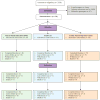A trial of family partnership and education interventions in heart failure
- PMID: 24331203
- PMCID: PMC3869235
- DOI: 10.1016/j.cardfail.2013.10.007
A trial of family partnership and education interventions in heart failure
Abstract
Background: Lowering dietary sodium and adhering to medication regimens are difficult for persons with heart failure (HF). Because these behaviors often occur within the family context, this study evaluated the effects of family education and partnership interventions on dietary sodium (Na) intake and medication adherence (MA).
Methods and results: HF patient and family member (FM) dyads (n = 117) were randomized to: usual care (UC), patient-FM education (PFE), or family partnership intervention (FPI). Dietary Na (3-day food record), urinary Na (24-hour urine), and MA (Medication Events Monitoring System) were measured at baseline (BL) before randomization, and at 4 and 8 months. FPI and PFE reduced urinary Na at 4 months, and FPI differed from UC at 8 months (P = .016). Dietary Na decreased from BL to 4 months, with both PFE (P = .04) and FPI (P = .018) lower than UC. The proportion of subjects adherent to Na intake (≤2,500 mg/d) was higher at 8 months in PFE and FPI than in UC (χ(2)(2) = 7.076; P = .029). MA did not differ among groups across time. Both FPI and PFE groups increased HF knowledge immediately after intervention.
Conclusions: Dietary Na intake, but not MA, was improved by PFE and FPI compared with UC. The UC group was less likely to be adherent with dietary Na. Greater efforts to study and incorporate family-focused education and support interventions into HF care are warranted.
Keywords: Self management; adherence; autonomy support; dietary sodium; medication adherence.
Copyright © 2013 Elsevier Inc. All rights reserved.
Conflict of interest statement
There are no disclosures or conflicts of interests.
Figures




Similar articles
-
Family partnership and education interventions to reduce dietary sodium by patients with heart failure differ by family functioning.Heart Lung. 2016 Jul-Aug;45(4):311-8. doi: 10.1016/j.hrtlng.2016.04.001. Epub 2016 May 9. Heart Lung. 2016. PMID: 27174641 Free PMC article. Clinical Trial.
-
Family education and support interventions in heart failure: a pilot study.Nurs Res. 2005 May-Jun;54(3):158-66. doi: 10.1097/00006199-200505000-00003. Nurs Res. 2005. PMID: 15897791 Clinical Trial.
-
Shared heart failure knowledge and self-care outcomes in patient-caregiver dyads.Heart Lung. 2018 Jan-Feb;47(1):32-39. doi: 10.1016/j.hrtlng.2017.11.001. Epub 2017 Nov 15. Heart Lung. 2018. PMID: 29153759 Free PMC article. Clinical Trial.
-
Family partnership intervention: a guide for a family approach to care of patients with heart failure.AACN Clin Issues. 2003 Nov;14(4):467-76. doi: 10.1097/00044067-200311000-00008. AACN Clin Issues. 2003. PMID: 14595206 Review.
-
Estimates of Dietary Sodium Consumption in Patients With Chronic Heart Failure.J Card Fail. 2015 Dec;21(12):981-8. doi: 10.1016/j.cardfail.2015.08.345. Epub 2015 Sep 18. J Card Fail. 2015. PMID: 26386452 Review.
Cited by
-
Low- Versus Moderate-Sodium Diet in Patients With Recent Hospitalization for Heart Failure: The PROHIBIT (Prevent Adverse Outcomes in Heart Failure by Limiting Sodium) Pilot Study.Circ Heart Fail. 2020 Jan;13(1):e006389. doi: 10.1161/CIRCHEARTFAILURE.119.006389. Epub 2020 Jan 21. Circ Heart Fail. 2020. PMID: 31959014 Free PMC article.
-
Nurse-coordinated home-based cardiac rehabilitation for patients with heart failure: A scoping review.Int J Nurs Sci. 2023 Sep 28;10(4):435-445. doi: 10.1016/j.ijnss.2023.09.022. eCollection 2023 Oct. Int J Nurs Sci. 2023. PMID: 38020827 Free PMC article.
-
A Pilot Trial Evaluating Collaborative Healthcare Encounters With Caregivers: A Checklist-Based Intervention for Primary Care.J Appl Gerontol. 2025 Feb 27:7334648251323688. doi: 10.1177/07334648251323688. Online ahead of print. J Appl Gerontol. 2025. PMID: 40015556 Free PMC article.
-
Dietary Sodium Restriction for Heart Failure: A Systematic Review of Intervention Outcomes and Behavioral Determinants.Am J Med. 2020 Dec;133(12):1391-1402. doi: 10.1016/j.amjmed.2020.06.018. Epub 2020 Jul 17. Am J Med. 2020. PMID: 32682866 Free PMC article.
-
Association of Medication Adherence and Health Status in Heart Failure With Reduced Ejection Fraction: Insights From the CHAMP-HF Registry.Circ Cardiovasc Qual Outcomes. 2024 Sep;17(9):e010211. doi: 10.1161/CIRCOUTCOMES.123.010211. Epub 2024 Jul 24. Circ Cardiovasc Qual Outcomes. 2024. PMID: 39045701 Free PMC article.
References
-
- Heart Failure Society of America. Lindenfeld J, Albert NM, Boehmer JP, Collins SP, Ezekowitz JA, Givertz MM, Katz SD, Klapholz M, Moser DK, Rogers JG, Starling RC, Stevenson WG, Tang WHW, Teerlink JR, Walsh MN. HFSA 2010 Comprehensive Heart Failure Practice Guideline. Journal of Cardiac Failure. 16(6):e1–194. - PubMed
-
- Bentley B, De Jong MJ, Moser DK, Peden AR. Factors related to nonadherence to low sodium diet recommendations in heart failure patients. European Journal Of Cardiovascular Nursing. 2005;4(4):331–336. - PubMed
-
- Bennett SJ, Lane KA, Welch J, Perkins SM, Brater DC, Murray MD. Medication and dietary compliance beliefs in heart failure. Western Journal Of Nursing Research. 2005;27(8):977–993. - PubMed
-
- Wu JR, Moser DK, Lennie TA, Peden AR, Chen YC, Heo S. Factors influencing medication adherence in patients with heart failure. Heart & Lung. 2008;37(1):8–16. - PubMed
Publication types
MeSH terms
Substances
Grants and funding
LinkOut - more resources
Full Text Sources
Other Literature Sources
Medical
Research Materials
Miscellaneous

